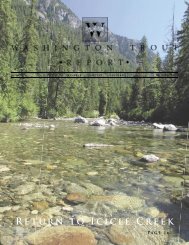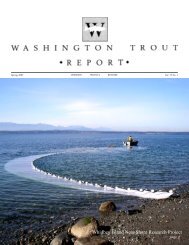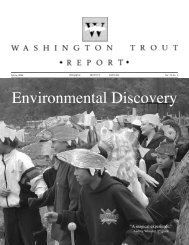Seafood Watch
Pacific Salmon - Wild Fish Conservancy
Pacific Salmon - Wild Fish Conservancy
- No tags were found...
Create successful ePaper yourself
Turn your PDF publications into a flip-book with our unique Google optimized e-Paper software.
<strong>Seafood</strong> <strong>Watch</strong>® Wild Pacific Salmon Report October 8, 2010<br />
I. Executive Summary<br />
This seafood report evaluates the ecological sustainability of wild-caught U.S. West Coast<br />
salmon. To make an overall recommendation, salmon fisheries have been analyzed using<br />
<strong>Seafood</strong> <strong>Watch</strong>’s five basic criteria: inherent vulnerability to fishing pressure, status of wild<br />
stocks, nature and extent of bycatch, effects of fishing methods on habitats and ecosystems, and<br />
effectiveness of the management regime. Due to the substantial variation observed between<br />
salmon fisheries, this report breaks U.S. West Coast salmon down along geographic lines (i.e.,<br />
by state – Alaska, Washington, Oregon, and California) in order to better inform consumers.<br />
The commercial salmon season in California and Oregon (south of Cape Falcon) occurs<br />
between May and September, and most product is sold fresh during these months. As a<br />
result, salmon from California and Oregon (south of Cape Falcon) is not readily available<br />
from October through April. Therefore, these fisheries are not evaluated using <strong>Seafood</strong><br />
<strong>Watch</strong>® criteria in this report, but general background information on these fisheries is<br />
included. An evaluation will be included when the season re-opens in 2011.<br />
Inherent Vulnerability<br />
Salmon have natural reproductive traits that imply a biological resilience to overfishing. They are<br />
relatively short-lived animals (two to five years on average) that release large numbers of eggs<br />
when spawning, indicating a high potential reproductive rate. However, the dependence of<br />
salmon on specific freshwater areas leaves them susceptible to habitat loss and concomitant<br />
population crashes. Notably, in the contiguous U.S. (i.e., the lower 48 states) numerous stocks of<br />
salmon have been severely depleted or entirely extirpated due to human activities. Where these<br />
downturns have occurred, remaining stocks are left considerably more vulnerable to fishing<br />
pressure. The comparatively pristine freshwater systems in Alaska have left salmon runs there<br />
comparatively resilient to fishing pressure.<br />
Stock Status<br />
As a result of habitat loss, climatic shifts, historic overfishing, and other factors, the abundance<br />
of many populations of salmon has declined substantially over the past century. Overall,<br />
Chinook, coho, sockeye, and pink salmon stocks in California, Oregon, and Washington have<br />
been significantly depleted from peak abundances, although fishing is not considered one of the<br />
primary causes of the declines in many cases. In Washington, several large runs continue to be<br />
viable. In several cases, long-term declines in abundance have been halted or reversed in the<br />
recent past. The health of Washington and Oregon (north of Cape Falcon) stocks are considered<br />
a moderate conservation concern because abundances and trends vary in space and time, with<br />
targeted stocks depleted from historical levels of abundance, but generally meeting conservation<br />
goals. In contrast, Alaskan salmon, augmented by large hatchery operations, appear to be in<br />
robust health, with record abundance and harvests over the past two decades. The status of<br />
Alaska salmon stocks is therefore a low conservation concern.<br />
Bycatch<br />
The gear employed in commercial salmon fisheries includes drift and set gillnets, purse seines,<br />
and trolling gear (also referred to as hook-and-line gear). When combined with management<br />
constraints such as area closures and gear restrictions, the methods used to catch salmon are<br />
highly selective for salmon, and overall bycatch rates appear low in all salmon fisheries.<br />
3






